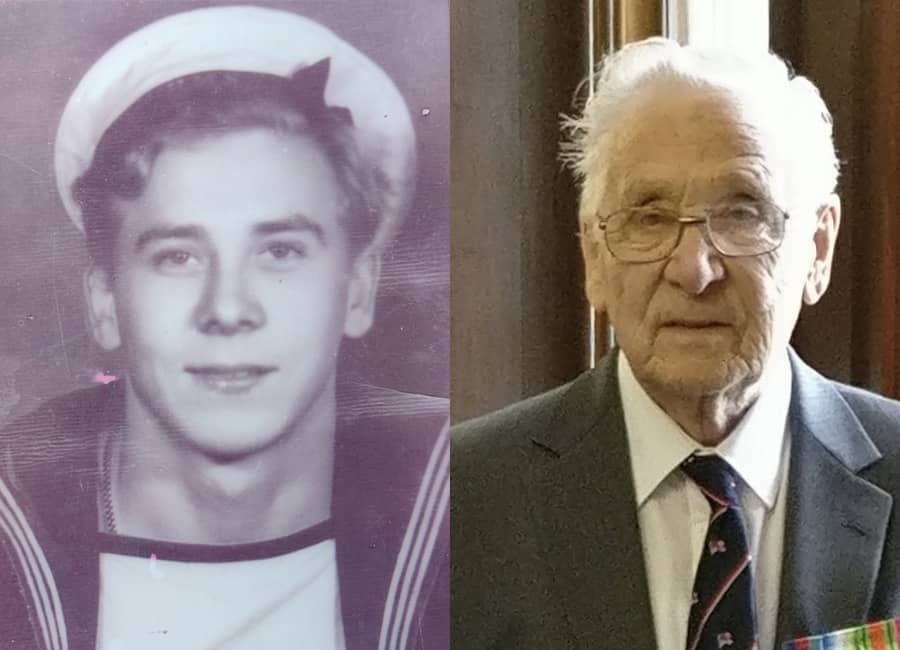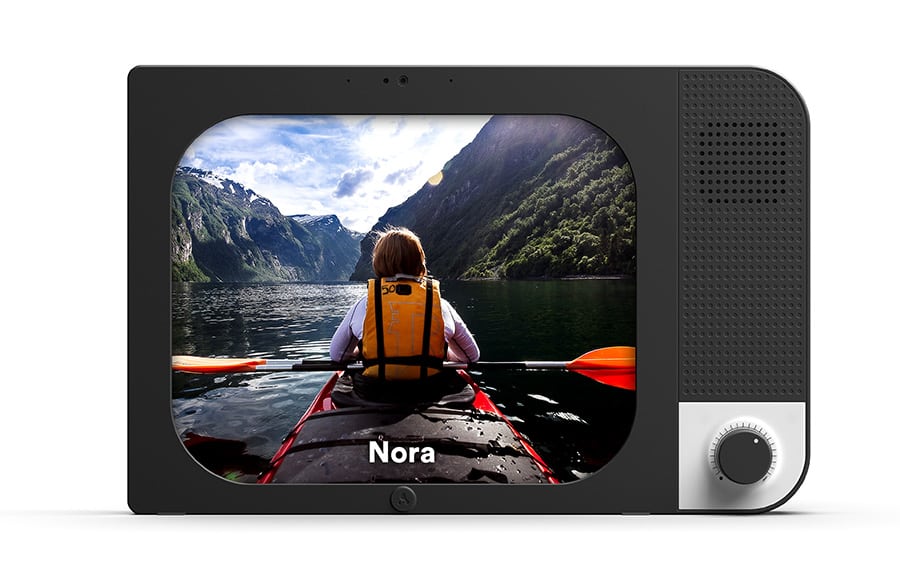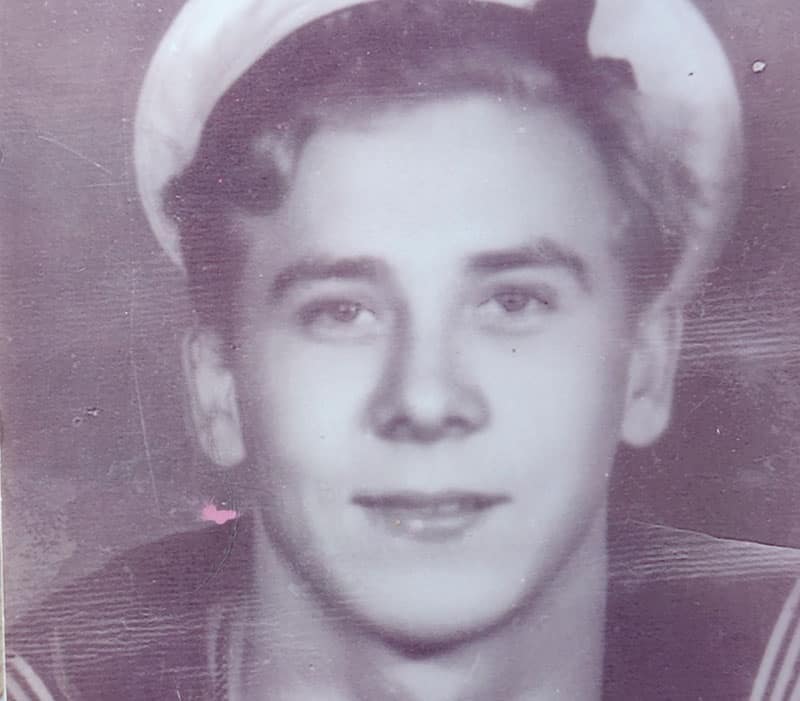Assistive tech to help Norway deliver largest ever crowdsourced “Thank You” to a British WW2 vet

In response to the cancellation of events on Friday 8th May commemorating the 75th anniversary of Norway’s liberation from Nazi occupation, the Scandinavian country is using technology in a bid to create the largest-ever (crowdsourced) expression of gratitude to a British military veteran of the campaign.
Kenneth Foster, 95, of Trowbridge, Wiltshire, a Royal Navy veteran of the campaign to liberate Norway, has been gifted a KOMP (produced by Oslo-based tech startup, No Isolation): a one-button computer more typically used to allow elderly people to receive images and video calls from family members.
In the run-up to the 75th anniversary of their nation’s liberation, the entire Norwegian population (5.3 million) is being invited to upload images (with text captions expressing greetings and thanks) and messages which will appear as part of a carousel display on Kenneth’s KOMP in his living room.
KOMPs are manufactured near to the Norwegian coastal town of Stavanger, a location with particular significance to Kenneth’s war experience, as he was a wireless operator on HMS Viceroy which returned the exiled Prince Olav (later King Olav V) to the city in May 1945.
Karen Dolva, CEO and co-founder of No Isolation, creator of KOMP, commented: “We are grateful for the sacrifices made by Britons like Kenneth in helping liberate our country seventy-five years ago. We were proud to step-up and offer our KOMP technology as a means for Norwegians to digitally say thank you and ensure that the current health crisis does not result in Kenneth – or any of his generation – feeling that their sacrifices have been forgotten. Takk, Kenneth!”

It comes as many seniors are precluded from using mainstream modern communication technology, both due to touchscreens not responding well to the dried-out fingers which age brings and due to the rapidly changing nature of digital innovation.
KOMP was created to overcome these challenges, says the company, with a simple single dial which, when switched on, allows the user to receive images, messages and video calls, thus allowing the elderly to be immersed in their family’s day-to-day lives.
The device has been designed to allow users to seamlessly receive messages, images and calls, rendering pre-existing or learnt digital skills unnecessary. By removing all usernames and passwords, the device is easy to grasp, giving seniors a sense of mastery over a piece of technology.
During the product’s research stage, the team identified that a lot of seniors experience leathery and dry fingertips when they grow older, due to decreased blood flow, making it difficult for them to use a touchscreen. As such, one large, graspable button was added to ensure ease of use.
The screen is placed at the senior’s house, and family and friends can connect and share content through an app. When the KOMP is turned on, the user will receive the messages, video calls and pictures sent throughout the day.
Sinking A U-Boat, Liberating Norway, and Drinking Juice On VE Day

At 17, Sheffield-born Kenneth joined the Navy and began his service as a Telegraphist on HMS Viceroy in 1944. By that stage in the war, there were only one hundred men in the ship’s complement and no doctor, just a Sick Berth Attendant (SBA).
Ken only got to know the men in his mess: the telegraphists (known as “sparkers”), signalmen (the “bunting tossers”), and coders. His action station was at the hoist for a gun turret: there were two Dual-Purpose (DP) 4-inch Guns and Ken had to take the 37lb shells from the hoist which raised them to deck level and, with a rope sling, convey them to the loader in the gun turret.
He recalled the process of liberation and reoccupation of Norway: “Just before VE Day our destroyer was sent out to Norway and we just happened to be on hand when Prince Olav was ready to return. We picked him up from a naval base in Scotland and took him to Stavanger.
“After that, the destroyers were given different places to liberate and we had military on-board to make sure the towns were adhering to the surrender conditions and following instructions.
“After Stavanger, the next place we visited was Trondheim and they were very pleased to see us. The town band turned out and we marched through the town with people lining the streets. It was all quite strange because when we arrived there were German soldiers in their grey uniforms and we didn’t really know what to do with them, so they ended up being in the crowd when we marched through. I think they were actually glad to see us as well.”
Kenneth’s memories of VE Day were distinctly sober ones, as he recalls how the men on the ship celebrated the end of the war with rum when they heard the news, but he was only allowed juice because of his age.
Outside of its role in the liberation of Norway, HMS Viceroy’s service meant that Kenneth was witness to some other remarkable events.
On 16 April 1945, HMS Viceroy was escorting Convoy FS 1874 off Sunderland when the German submarine U-1274 attacked, torpedoing and sinking the tanker Athelduke. Kenneth’s ship counterattacked, sinking the submarine north of Newcastle.
Ken recounted the dramatic encounter: “While on the Viceroy we sank a U-boat which created a lot of wreckage. There was a huge container which should have contained life rafts, but instead, it was full of bottles of schnapps. We sent a presentation of the schnapps to Churchill. He wrote back congratulating us for the attack and thanked us for the brandy. I’ve still got the Prime Minister’s letter, signed by him.”
After the war, Kenneth worked for the Post Office and as a war pensions officer and is also part of the White Ensign Association, a society for ex-members of the Royal Navy. He has visited Norway on several occasions since his part in the liberation and still has many friends in the country.
In 2017, Kenneth was awarded a Norwegian Medal of Honour for the role he played in liberating the country.



